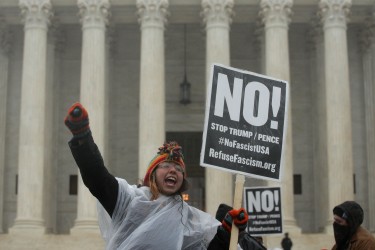Whether the nativist groups that incited racial violence during the interwar years in the US – with the aim of keeping the nation “one hundred per cent American”, in their words – are properly, or usefully, understood as “fascist” is a question that has exercised historians for decades. More than 100 such groups were identified in the early 1930s by the American Civil Liberties Union, most of which either imitated the European coloured shirt movements (so that by 1934 the US had the Silver Shirts, the White Shirts and Gentile League, the Khaki Shirts, the Gray Shirts, and many others) or formed militant Christian groups, such as “Defenders of the Christian Faith” or the “Christian Front”. Together they declared their hatred of “alien” elements and ideas, including not only other religions (primarily Judaism) and races, but also liberalism, socialism and communism, all of which they lumped together in the name of jingoist nationalism: such groups always declared themselves “pro-American”.
As such groups could originate in economic populism, evangelical Christian nationalism (which could be anti-Semitic, anti-Catholic, or both), or in historical white supremacy, some historians have concluded that they represent uniquely American disorders: aberrations created by the nation’s fraught history of the tension between its ideals of liberal democracy for (white male) citizens and the authoritarian systems under which it subjugated everyone else.
The argument that American nativist, xenophobic, conspiratorially anti-Semitic and white supremacist paramilitary groups were categorically different from their counterparts in Europe was much less likely to be made during the interwar years, however – not least because almost everyone could see the way they both leveraged existing bigotries on behalf of reactionary populism.
Historians of fascism have also demonstrated that all fascism is indigenous by definition. As Robert O Paxton explained in his seminal 1998 essay “The Five Stages of Fascism”, “authentic fascism is not for export” because all fascisms draw “their slogans and their symbols from the patriotic repertory of one particular community”. Paxton also noted that “religion, for example, would certainly play a much greater role in an authentic fascism in the United States than in the first European fascisms”.
American fascism will be ultra-American. It will reject the atheism and statism of European models; it will be self-righteous, certain of its own innocence, and understand itself as libertarian. Nativist agrarianism goes to the heart of these American populist mythologies, as it did to the rhetoric of both Mussolini and Hitler, promising to regenerate the nation – to make it great again. It elevates an authentic, preferably rural, national folk and defines them as “real Americans”, while denying first the loyalty, then the citizenship, then the humanity of everyone else. That authoritarian, nativist solutions to political problems did not find traction in the US in the 1930s does not prove that they never could; American exceptionalism did not immunise it against fascism, and it had its own organically fascistic movements that enjoyed popular support and sought entrenched power during the interwar years.












